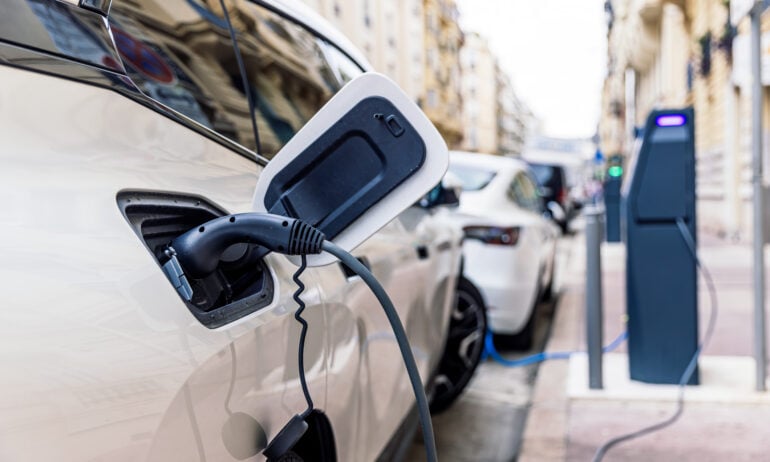How Do Hybrid Cars Work?
Learn how hybrid electric vehicles (HEVs) work, the benefits of driving on and how they compare to other car types.

Many, or all, of the products featured on this page are from our advertising partners who compensate us when you take certain actions on our website or click to take an action on their website. However, this does not influence our evaluations. Our opinions are our own. Here is a list of our partners and here's how we make money.
Table of Contents
Hybrid electric vehicles blend the strengths of a gasoline engine with the efficiency of one or more electric motors, powered by batteries. Instead of relying on just one power source, hybrids use both gas and electricity—working together or independently—to deliver better fuel economy, lower emissions and a smoother driving experience.
The basics of how hybrid cars work
At their core, hybrid vehicles have two main power sources.
Internal combustion engine (ICE). This is the same type of engine found in traditional gas-powered cars.
Electric motor. Powered by a battery, this motor can drive the car on its own or assist the gas engine.
What makes hybrids unique is how these two systems interact. Depending on the situation, the vehicle can:
Run on the gas engine only.
Run on the electric motor only (with distance limitations).
Use both the gas engine and electric motor together.
This switching happens automatically, behind the scenes, to optimize efficiency based on driving conditions.
» MORE: Hybrid cars buying guide
Key hybrid components and how they work
To understand how hybrid vehicles work mechanically, here’s a look at the major parts that keep them moving.
1. Traction battery pack
Stores electricity for the electric motor.
Recharges through regenerative braking (more on that below) or with help from the gas engine.
Unlike plug-in hybrids or EVs, standard hybrids do not need to be plugged in to recharge.
Hybrids also have an auxiliary battery used to start the car before the traction battery engages. The auxiliary battery also powers vehicle accessories.
2. Electric traction motor
Uses power from the traction battery to turn the vehicle’s wheels.
Some vehicles use motor generators that combine the drive and electric regeneration functions.
3. Electric generator and regenerative braking
Generates electricity from the rotating wheels while braking.
Transfers that energy back to the traction battery.
Saved energy can immediately power the vehicle the next time it accelerates, while delaying the restart of the gas engine.
Electric generators on some hybrids combine the regeneration and drive functions.
4. Powertrain
Hybrids have different ways of creating and using power. There are three types of hybrid systems.
Parallel hybrids. These use the gas engine and one or more electric motors to directly power the wheels. Parallel systems are the most common.
Series hybrids. These use only the electric motor to drive the wheels. The gas engine does not directly power the drivetrain, but instead acts as a generator to charge the battery. Series systems are less common.
Series-parallel hybrids. These combine the advantages of parallel and series systems by using a power-split device. Either the engine or the electric motor can directly power the wheels, or both can be used simultaneously. This system is most often found on Toyota models.
5. Gasoline engine
Similar to the engine in conventional vehicles.
Extra power provided by the electric motor allows for a smaller engine.
When does a hybrid’s electric motor kick in?
There are four situations in which the electric motor usually does the most work.
Low-speed driving. In stop-and-go traffic or at lower speeds, many hybrids rely on the electric motor alone.
Idling. When the vehicle is stopped at a red light, the gas engine may shut off completely to save fuel.
Gentle acceleration. As the vehicle accelerates from a stop, electric power moves the car forward and may be the only source of power until the vehicle hits about 25 mph.
Deceleration or braking. The electric motor turns into a generator, feeding energy back into the battery.
When more power is needed, such as during highway driving or quick acceleration, the gas engine steps in to help or take over entirely.
What does a hybrid’s start/stop function do?
Another key feature in many hybrids is an automatic start/stop system, which does three things:
Turns off the engine when the car comes to a complete stop.
Restarts the engine instantly when you take your foot off the brake or press the accelerator.
Saves fuel during idle time, especially in traffic or at long stoplights.
The benefits of hybrid design
Thanks to their mechanical design, hybrids offer several benefits.
Better fuel economy. Using the electric motor at low speeds helps reduce fuel use.
Lower emissions. Less gasoline burned means fewer harmful emissions.
Quieter operation: Driving on electric power is nearly silent.
Less wear on brakes. Regenerative braking reduces strain on traditional brake systems.
No need to plug in. Standard hybrids charge themselves while you drive.
How full hybrids work compared to mild hybrids
Full hybrids, also called FHEVs, have larger batteries and more powerful electric motors than mild hybrids. FHEVs can operate just on the electric motor, the gasoline engine or a combination of both.
Mild hybrids, also called MEVs or micro hybrids, have a smaller electric motor and battery than a full hybrid. Mild hybrid systems cannot power the vehicle using electricity alone.
How do hybrids compare to plug-in hybrids?
Plug-in hybrids (PHEVs) focus more on electricity to power the vehicle. They work similarly to regular hybrids but have these differences.
Larger batteries.
Longer electric-only driving range.
Ability to charge via an external charger.
With a plug-in hybrid, you can drive on electric power alone for a set number of miles before the gas engine kicks in. PHEVs may be a good option for people who want the benefits of electric driving without worrying about range limitations.
» MORE: How the EV tax credit works
How hybrids work vs. electric vehicles
Hybrid (HEV) | Electric Vehicle (EV or BEV) | |
|---|---|---|
Power source | Gas + electric. | Electric only. |
Charging | Charges while driving (no plug-in needed). | Requires external charging. |
Emissions | Lower than gas-only cars. | Zero tailpipe emissions. |
Fuel savings | Moderate to high. | Highest, but varies by electricity cost. |
Range | Unlimited with gas. | Limited by battery range. |
Hybrid technology offers a unique combination of benefits not available from other types of vehicles. Hybrid drivers can save money by reducing gas consumption, avoid range anxiety thanks to the gas engine and skip the hassle of finding a place to plug-in.








